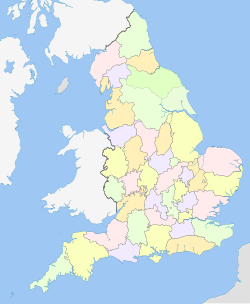Traditional counties of England
| County | |
|---|---|
|
Also known as: Shire |
|

Counties of England in 1851 with major rivers, the ridings of Yorkshire, and the remaining exclaves shown
|
|
| Category | County |
| Location | England |
| Found in | Kingdom |
| Created | 5th–11th century |
| Number | 39 (as of 1 April 1889) |
| Possible status | County palatine |
| Populations | c. 21,000—3.4 million (1881) |
| Areas | c. 94,000–3.8 million acres (15,000 km2) (1881) |
| Government |
Shire Court Shire-reeve (until 1066) Ealdorman Earl (from 1066) Quarter sessions (16th century–1889) County council (from 1 April 1889) |
| Subdivisions | Division, riding, rape, part Hundred and equivalent Parish |
The historic counties of England were established for administration by the Normans, in most cases based on earlier kingdoms and shires established by the Anglo-Saxons and others. They ceased to be used for administration with the creation of the administrative counties in 1889. They are alternatively known as ancient counties, as traditional counties. or as former counties. Several historic counties continue to be recognised as cultural regions and have their own county days, county flags and boundary signs, many of which were created or registered after these counties ceased to be used as units for administrative purposes.
Unlike the partly self-governing boroughs that covered urban areas, the counties of medieval England existed primarily as a means of enforcing central government power, enabling monarchs to exercise control over local areas through their chosen representatives – originally Sheriffs and later the Lord Lieutenants – and their subordinate justices of the peace. Counties were used initially for the administration of justice, collection of taxes and organisation of the military, and later for local government and electing parliamentary representation. They continue to form the basis of modern local government in many parts of the country away from the main urban areas, although sometimes with considerably altered boundaries.
The name of a county often gives a clue to how it was formed, either as a division that took its name from a centre of administration, an ancient kingdom, or an area occupied by an ethnic group. The majority of English counties are in the first category, with the name formed by combining the central town with the suffix "-shire", for example Yorkshire. Former kingdoms, which became earldoms in the united England did not feature this formulation; so for Kent, the former kingdom of the Jutes, "Kentshire" was not used. Counties ending in the suffix "-sex" are also in this category and are former Saxon kingdoms. Many of these names are formed from compass directions. The third category includes counties such as Cornwall and Devon where the name corresponds to the tribes who inhabited the area.County Durham is anomalous in terms of naming and origin, not falling into any of the three categories. Instead it was a diocese that was turned into the County Palatine of Durham, ruled by the Bishop of Durham. The expected form would otherwise be "Durhamshire", but it was rarely used.
...
Wikipedia
